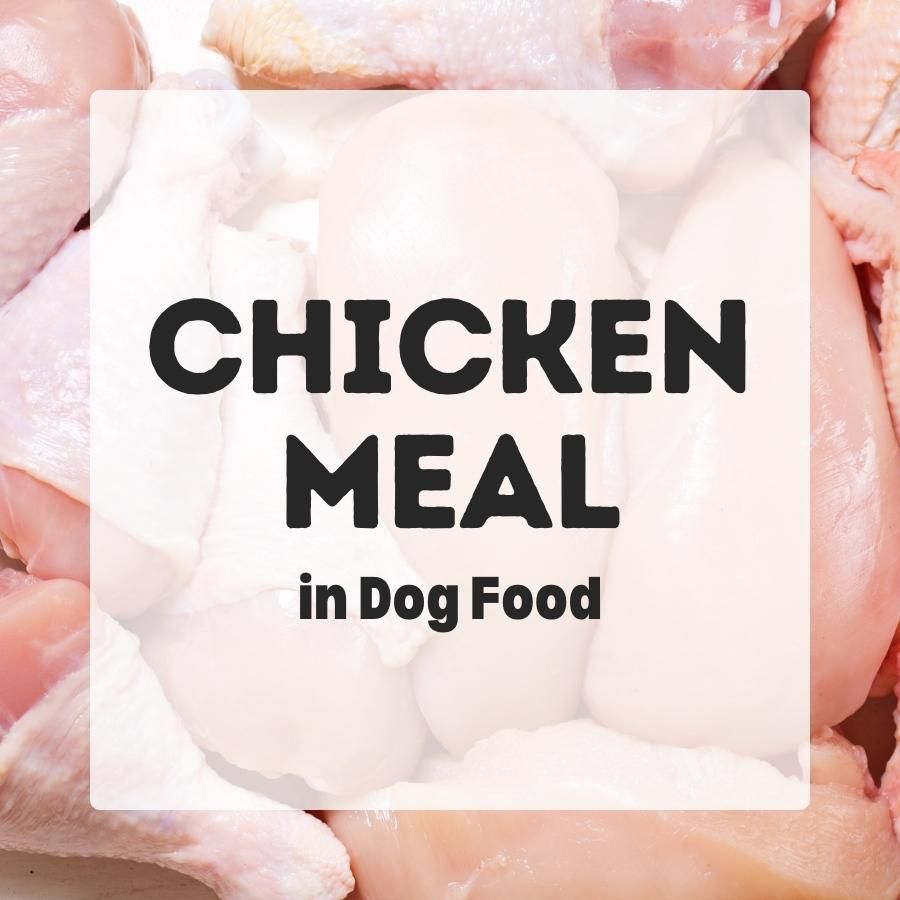Chicken meal in dog food is a very common ingredient. In this article, you’ll learn what it is and why it’s in your dog’s food.
Contents
What is Chicken Meal?
Chicken meal is one of the more common protein sources used in dog foods, much like beef meal or poultry meal.
But it’s not real chicken. Instead, it is made from slaughterhouse waste materials. This includes meat scraps and skin with or without bones or parts of whole chicken carcasses.
In the next step, these chicken tissues are processed by rendering.
This means they are ground, heated to high temperatures, and pressed. This process separates the chicken fat and yields a solid cake that is ground into a highly concentrated protein powder.
Unlike chicken by-product meal, a chicken meal does not make use of heads, feet, and viscera.
And per the official definition, that’s about all the difference there is between these two ingredients[1].
Chicken Meal Nutrients
Chicken meals are semi-defatted and contain lower levels of saturated fatty acids when compared to fresh chicken[3]. They are also a little less digestible compared to gently cooked or raw chicken[5,6].
A 2019 study compared the nutrient digestibility of chicken-based ingredients and found chicken meal to have a lower nutrient digestibility than less processed chicken ingredients[6].
According to this study, chicken meal may not be sufficient if used as the sole protein source for dogs to meet the minimum protein recommendations of AAFCO or NRC!
While chicken meal may not have the same qualities as fresh chicken meat or giblets, it is a cost-effective and efficient way to add animal protein into dog food formulas.
Chicken meal has a high nutritional value with a high content of protein and minerals. It is a popular ingredient used by many brands of dog food.
But apparently, it has to be balanced with other protein sources that provide the missing essential amino acids such as methionine, tryptophan, and threonine.
Chicken Meal in Dog Foods
Meat meals do not always enjoy the best reputation.
This is understandable when you consider that many of the ingredients that go into meat meals have little nutritional value, and rendering is a way to dispose of unmarketable animal parts.
But chicken meal is a value-added ingredient.
Chicken meal contains <10% of water while fresh chicken has about 65%[2]. When processed for dry dog food, fresh chicken will shrink considerably because all of this water is boiled off.
Chicken meal, on the other hand, had its water removed in advance.
Simply put, chicken meal is packed with protein and doesn’t have much water, so you don’t need to use a lot of it in dog food to get the same nutrition as from large amounts of fresh chicken.
It’s also a named ingredient, so the source of animal protein in your dog’s food is a little more transparent.
Chicken by-product meal is often considered as an inferior ingredient because it can contain a lot more hard-to-digest stuff like connective tissues, feet and beaks.
However, both ingredients are largely produced from by-products and can vary significantly in quality and composition.
Overall, there are few studies that address the nutritional differences between these two ingredients. So it’s hard to say if chicken meal really is the better ingredient[4].
Dog foods with “chicken” in their name have to contain some real chicken. Since a chicken meal is less expensive and not considered real chicken when naming products.
Some suppliers offer dehydrated or dried chicken meat or protein powders that are dried more gently than meals. These can be reconstituted and in theory be labeled as “with real chicken“.
Further Reading
[1] AAFCO Official Publication. Chapter 6. Free Access.
[2] Montegiove et al. An Alternative Approach to Evaluate the Quality of Protein-Based Raw Materials for Dry Pet Food. Animals. 2021. https://doi.org/10.3390/ani11020458
[3] Montegiove et al. Comprehensive evaluation of lipidic content in dry pet food raw materials: Comparison between fresh meats and meat meals (pdf). Sci Bull. Ser F Biotechnol. 2020.
[4] Hillary Watson. Poultry Meal versus Poultry By-Product Meal. Dogs in Canada. 2006.
[5] Swanson et al. Chemical composition, nutrient digestibility, and true metabolizable energy of differentially processed chicken-based pet food ingredients using the precision-fed cecectomized rooster assay. Journal of Animal Science. 2017. https://doi.org/10.2527/asasann.2017.228
[6] Oba et al. Chemical composition, true nutrient digestibility, and true metabolizable energy of chicken-based ingredients differing by processing method using the precision-fed cecectomized rooster assay. Journal of Animal Science. 2019. https://doi.org/10.1093/jas/sky461
